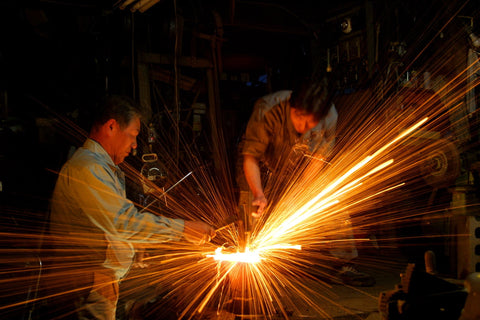I have never met Akiko Moritaka in person, but we have exchanged many emails. Wife of 27th generation Moritaka craftsman Tsunehiro Moritaka, Akiko-san is responsible for the family business’ international outreach. Our conversations have never gone beyond the limit of her English, but that didn’t stop her passion for the family’s 700+ years-long knife-making history from being felt.
Founded in 1293 (yes you have read that correctly!) by Kongohyoe Minamoto no Moritaka (金剛兵衛源盛高), Moritaka Hamono — for its first 13 generations — has been the official sword-smith for Buddhist priests at Mt. Homan in Dazaifu, Fukuoka. During that period, it is believed that Buddhist Gods lived in Mt. Homan, and Dazaifu became a spiritual fertile land where monks gathered. The demand for swords by monasteries has kept the family business going until the Sengoku Period, when Japan experienced almost constant civil wars. By the year 1632, the monasteries in Mt. Homan were in ruin, and the Moritaka family followed the Lord of Kumamoto, and moved the family to Myoken shrine (known as Yatsushiro Shrine today) where the arrival of the powerful feudal lord Kato Kiyomasa in 1622 has revived the spiritual land. The demand for swords was back and the Moritaka family continued making swords for Buddhist guards for another 13 generations.
A family business cannot survive 700 plus years without a survival instinct ingrained. Moritaka’s family motto has always been “to be tenacious through craftsmanship, to always look for means with a sense of crisis”, and the 21st generation Chuzaemon Moritaka followed the motto and started the transition of Moritaka blade-making from swords to chef knives.
If you take a 2-minute walk from Yatsushiro Shrine today, you’ll find the small Moritaka workshop sitting next to the mountains of Tobusanroku Natural Park. Inside the 27th generation Moritaka blacksmith — Tsunehiro Moritaka — would be busy working with his father, another master craftsman and his apprentice. Together the four of them make all the Moritaka knives.
Today’s Moritaka probably bears little resemblance to the days of sword-making for feudal lords. In all honesty, Moritaka today is a maker of very affordable yet solid hand-forged chef knives. The simple Kurouchi finish means you are almost paying for the forge alone. If you are looking for refined polishes, or super smooth geometry, or high-end fit and finish, you should probably look elsewhere. But at their entry to lower-middle price points, with Aogami steels properly heat-treated to superb hardness, great edge retention, the ability to easily sharpen, and a pretty awesome rural looking Kurouchi finish, Moritaka has got quite many fans, especially in the West. And the West seems to be where the Moritaka is headed. Ever since the family started selling to overseas a little over 10 years ago, they have quickly accumulated fans in over 50 countries. I’m not sure how this success has influenced their products, but their “Deba” and “Yanagiba” in fact have double-edged Warikomi construction. The family has Akiko-san to thank for — her keen interest in learning English has given the little family workshop an early entry into the emerging markets of Japanese knives in the US and Europe, and a new chapter in its long story. I guess the family’s motto is still in its full force.

